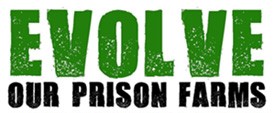Feds’ rethink on prison farms, abattoirs started in 2003
1,000 pages of government documents tell what unfolded after that
Ontario Farmer [click to view original article], Tue May 11 2021, Ian Cumming
See also Bloody Bad Business: Report on the Joyceville Institution Abattoir
 When the federal government shut down the Joyceville Institution prison farms in March 2011, it decided to maintain the active slaughter facility on site.
When the federal government shut down the Joyceville Institution prison farms in March 2011, it decided to maintain the active slaughter facility on site.
It had already been leased out to a private company, Wallace Meats, for several years prior, with an agreement to use a handful of prison labour. The lease payments made money from what would otherwise be an empty facility.
There are 871 square meters of abattoir space and 1,721 square meters of barn space for the slaughter animals. The prison system describes it as being run on a “neutral operational cost basis.”
Many short-term leases were enacted over the years, always to the same company, despite occasionally advertising for tenders. The present lease runs to September 2021.
Just as the former non-quota prison dairy farm had supplied milk and some dairy products to all federal prisons in Ontario and Quebec, this slaughter facility supplied the meat from hogs and cattle to them as well, having its own refrigerated truck to deliver product to the prisons.
There were well over 1,000 documents received under federal Access to Information requests obtained by Ontario Farmer regarding these prison operations. First requested in December 2018, the government refused to release any documentation under this venue, until a Feb. 2, 2021 ruling by Caroline Maynard, Information Commissioner of Canada, ordered them to do so.
“Being late to respond to an access request because of “internal” consultations is unfair to Canadians and puts the credibility of the access system in question,” she wrote.
The documents show that the first government shift from that policy of prisoners eating meat slaughtered within that the prison system, occurred when there was pushback from Muslim prisoners in the system in October, 2003.
“The Muslims at PIU are refusing to use Wallace Beef Halal Beef (just before the abattoir situation came about) so I expect they will want the Chief of Food Services to assure them that any Halal Meat Products come from an approved source,” stated an internal Oct. 16, 2003 email.
An investigation found that different knives were not being used for the different streams of slaughter, “using the same knives on pigs” or they had not been washed the required seven times after being used on traditional cattle meat.
An email the next day warned that “due to the severity” of what they were finding at the slaughter facility, which was involving three police forces and MNR investigating, “no one would need media requests.”
Correspondence between top officials in government and the prison system stated that there was evidence of “improper slaughtering and meat handling to money laundering and drug related activities.”
From then on, over the next several years, documents show a government focus on obtaining detailed studies on how to extracate themselves from the model of these farms and slaughter facility providing dairy and meat products to these federal prisons.
Data showed that “less than one per cent” of prisoners returning to society worked in the agriculture sector, despite the active prison farms.
Technology was also resulting in fewer prisoners having to work on-farm or in the slaughter plant. Documents show that, from 1995 to 1997 inclusive, 92 to 109 prisoners per year worked at these facilities. The slaughter facility utilized 25 to 27 of those men.
From 2008 to 2010 inclusive, just before the dairy farm shutdown, those total numbers were 40 inmates working in these facilities in 2008 and dropping to 34 by 2010. There were 19 of that total in the slaughter facility in 2008 and three in both 2009 and 2010.
From 2013 to 2018 documents show zero inmates working on the prison farm and four to 10 working in the slaughter facility. Although emails show that, on some occasions, like in 2014, there were zero inmates at the slaughter facility, even though the work was available to them.
“Why are we subsidizing a private company when they aren’t employing inmates?” asked an Oct. 8, 2014 email.
Documents show that, from March 2018 to March 2019, there were 6,286 total hours put in by inmates at the slaughter facility, with Level A (skill level) prisoners receiving $6.90 per eight hour day and Level D inmates receiving $5.25 per day.
There are 473 employees at the medium security facility at Joyceville, plus 134 employees at the minimum facility. Their average pay is $74,802 a year.
When the different federal government revitalized the prison farms and promised funding for 60 to 70 inmate jobs on Feb. 28, 2019, a subsequent meeting was documented with a local MP.
He was asked if these jobs, which were never required in that number prior, were “catering to foreign interests” with the proposed huge goat farm to supply milk to the Feihe plant? If the product was sent for export, it would be illegal under Canadian law which does not import goods made by prison labour.
“He was very angry and accuses us of trying to usurp something that other people have been working toward for years,” stated the meeting report.
In 2016, the federal government began to explore the possibility of reopening the prison farm. There had been continued pressure from a local protest group to start milking cows there again.
An exhaustive report by Monachus Consulting for the government laid bare many of the arguments the proponents were making to the press and at public meetings.
The land was presently being rented out to capable farmers, but dairy quota would need to be purchased, which had not existed before. And the buildings and equipment were in disrepair or obsolete, they wrote.
“High management costs, in terms of supervision in the abattoir and in other re-established processing facilities could make meeting market prices immensely challenging,” stated the report.
It did a detailed survey that, if the Kingston community was so in favour of rehabilitating prisoners on farms, could they go out to area farms to work? The report noted that 44.9 per cent of Kingston-area farmers said no, while the percentage of no in the rest of the country for prisoners working on farms varied from 13 to 26 per cent.
Another study by Goss Gilroy, also in 2016, found that, among the proponents of reopening the prison farms, there was “a lack of awareness both at the employment activities of CSC’s offender population and of CORCAN’s population in general.”
With these reports in hand, then Minister Goodale told a 300-person rally in Kingston on Aug. 30, 2016 that prisoners working on farms, “would provide good and varied prospects for future employment. Bring the cows home.”
On Feb. 28, 2019, the federal government gave $4.3 million for the reopening of the prison farms.
